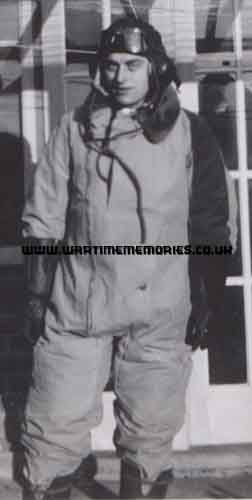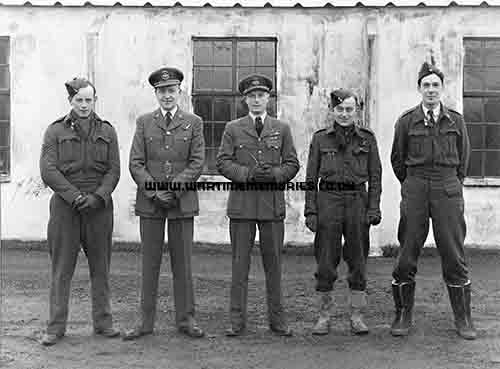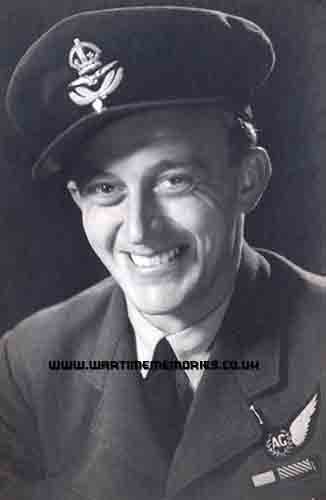|
|
|
RAF Croft
RAF Croft is one of the most northerly of the airfields built during
the Second World War for use by Bomber Command. Construction work
started in 1940 and it was developed into a standard bomber airfield
with three concrete runways. Known officially as Croft it was commonly called Neasham by local inhabitants. The airfield opened in 1941 as a satellite for Middleton St.George. The airfields were in No.4 Group, Bomber Command, and the first squadron to arrive at Croft was No.78 Squadron which brought its Whitleys in from Middleton St.George on October 20th 1941.
During March and April 1942 No.78 Squadron began to re-equip with the Halifax, ith much training activity as well as continuing operations. On 10th June 1942 no.78 Squadron departed and for a while Croft was out of use whilst runways were strengthened and lengthened to better accommodate 4-engine heavy bombers. The station was destined to become a conversion training base when, on October 1st 1942, No.419 Squadron RCAF arrived from Topcliffe, to be equipped with Halifax Mk.IIs. On November 9th 1942 they moved to Middleton St.George with their new aircraft, and were immediately replaced by newly formed 427 (Lion) Squadron RCAF. On January 1st 1943, Croft was transferred to No.6 Group RCAF and sometime during March, the station became No.64 Base Sub-station under the control of Middleton St.George. After initial training, 427 Squadron was equipped with Halifax B Mk.Vs and on the 4th of May 1943 they moved to 63 (RCAF) Base at Leeming.
On May 10th No.1664 HCU formed at Croft. Equipped with Halifaxes, the unit's role was to provide conversion training on these aircraft. Training was continous, and with such a crowded circuit there were many crashes, and sadly, many fatalities. No.1664 HCU moved to Dishforth on December 7th 1943.
RAF Croft then reverted to an operational bomber base. On December 10th, 431 (Iroquois) Squadron arrived from Tholthorpe, and the following day was joined by No. 434 (Bluenose). Both Canadian units were to make Croft their last home in England. During March 1944, 431 Squadron re-equipped with Halifax Mk.IIIs, and the following May, No.434 Squadron followed suit. 431 & 434 Squadrons converted onto the Canadian built Lancaster MkX & Xa during December 1944 and it was these aircraft that they flew home to Dartmouth Nova Scotia in June 1945, where they were disbanded on September 5th 1945.
After the departure of the two RCAF units, Croft saw very little
activity until being brought back into use in the Autumn as a satellite
for No.13 Operational Training Unit which flew Mosquitoes from Middleton St.George. Croft finally closed to flying in the summer of 1946.
Today the site is home to a motor racing circuit. Parts of the runways remain although most of the buildings have been demolished. A memorial has been erected at nearby Dalton village.
Squadrons stationed at RAF Croft
- No.78 Squadron from October 20th 1941 to 10th June 1942
- 419 Squadron 30 Sept 42 to 9 Nov 42
- 427 Squadron formed at Croft on 7 Nov 1942; left on 4th May 1943
- 1664 HCU formed at Croft 10th May 1943; left on 7th December 1943
- 431 Squadron from 10 Dec 1943 to June 1945
- 434 (Blue Nose) Squadron from 12 Dec 1943 to June 1945
Photographs
History of RAF Croft
20th October 1941 Relocated
8th Nov 1941 78 Squadron Whitley lost
15th Jan 1942 Operations
March 1942 New aircraft
29th April 1942 Halifax mission
30th May 1942 1000 bomber raid
5th Jun 1942 Halifax Lost
10th June 1942 Relocated
7th November 1942 New bomber squadron formed
2nd Jan 1943 Operations
9th Jan 1943 Gardening
15th Jan 1943 Ops
21st Jan 1943 Gardening
26th Jan 1943 Ops
29th Jan 1943 Ops
30th Jan 1943 Ops
24th Dec 1943 Christmas Party
22nd Jan 1944 433 Squadron Lancaster lost
24th Mar 1944 Berlin Targeted
6th Jun 1944 Coastal Defences
6th Jun 1944 Supply Lines
2nd Nov 1944 Mascot's First Flight
15th Jan 1945 12 Squadron Lancaster lost
Mar 1945 Fighters in the Stream
4th Mar 1945 Enemy Raider
If you can provide any additional information, please add it here.
|
Those known to have served at RAF Croft during the Second World War 1939-1945. - Adlam. Oscar Philip Edwin Ronald J. Sgt (d.12th Feb 1943 )
- Armour. Edson Gilroy . F/O. (d.18th Mar 1944)
- Badgery. Frank Alexander .
- Baker Victor. (d.20th Jan 1944 )
- Ball William . Sgt. (d.12th Feb 1943)
- Ballentine. Robert E.. P/O. (d.18th Mar 1944)
- Brest C. S.. F/O (d.20th Jan 1944 )
- Brest Clarence Samuel. F/O (d.20th Jan 1944)
- Campbell James Reith. Flt Lt (d.2nd Nov 1941)
- Carter Roy. F/O. (d.9th Jul 1944)
- Cassey . Colin. (d.20th Jan 1944 )
- Charlton. Herbert P D . Sgt. (d.9th Oct 1943)
- Clifford Arnold C . Sgt. (d.12th Feb 1943)
- Clinksgill James. (d.20th Jan 1944 )
- Connor DFC.. Donald Daubney. F/O. (d.1st November 1944)
- Copeland Thomas Donovan . F/O (d.11th March 1944)
- Corbett Jane.
- Cotton. Walter . Sgt. (d.18th Mar 1944)
- Cox R T . Sgt
- Dack P R A . Sgt (d.20th Jan 1944 )
- Dean A P. Sgt
- Doe L H . Sgt (d.20th Jan 1944 )
- Doe Leslie Hubert. Sgt. (d.20th Jan 1944)
- Drumm W C. P/O
- Duggan Rennie Frank. Sgt. (d.2nd Nov 1941)
- Dunn. Bryan . F/O (d.12th Feb 1943)
- Evans. David C. . F/O (d.18th Mar 1944 )
- Fern. Raymond John . F/Lt. (d.11th March 1944)
- Gilliam. David. (d.20th Jan 1944)
- Gnius M. P/O. (d.20th Jan 1944)
- Heron Angus Brown.
- Highsted. Raymond H . F/O (d.28th Sep 1943)
- Hill H B . Sgt (d.20th Jan 1944 )
- Hill Henry Bolton. P/O (d.20th Jan 1944)
- Hill John Raymond. W/O
- Holland Ron.
- Hutt. Geoffrey . P/O (d.18th Mar 1944 )
- Jackson. Donald E.. P/O (d.18th Mar 1944)
- Jelley. William C I . Sgt (d.12th Feb 1943)
- Johnstone Mervyn M.. F/Lt
- Joiner Raymond Conserdine. P/O. (d.1st November 1944)
- Jones Charles. (d.20th Jan 1944 )
- Jones. William . P/O. (d.11th March 1944)
- Keen CGM, DFM.. Geoffrey Frank. Sqdn.Ldr.
- Kipp W M. P/O
- Kipp Wilf M.. P/O
- Latremouille. Joe Richard . F/O (d.11th March 1944)
- Luckett. Frederick J . Sgt (d.28th Sep 1943)
- Lumsden W. Sgt
- MacKay Angus.
- Marceau. Henri Bernard . F/O
- Matthews. C. A. . P/O
- McCaffrey Edwin. (d.20th Jan 1944)
- McGregor. R E . Sgt (d.20th Feb 1944)
- McKay Angus.
- McKenna J A . Sgt (d.20th Jan 1944)
- Mercer James. Sqn. Ldr. (d.2nd Nov 1941)
- Misset Ann.
- Mitchell DFC, CD.. Eric Martin. Wing Cmdr.
- Mitchell. John C . Sgt (d.28th Sep 1943)
- Morgan J R. Sgt (d.20th Jan 1944 )
- Morgan John Robert. Flt Sgt. (d.20th Jan 1944)
- Mortimer Don. P/O
- Mould G C. Sgt (d.20th Jan 1944)
- Mulvaney . James Joseph. F/O.
- Murphy Stewart W.. P/O.
- Murray. . F/O (d.20th Feb 1944 )
- Nelson. James . Sgt (d. 28th Sep 1943)
- Oram William John. Sgt (d.22nd January 1943)
- Parlour Joan.
- Pearce. A G . Sgt (d.20th Feb 1944 )
- Perry John Ralph Marwood. Sgt.
- Perry John Ralph Marwood. Sgt.
- Pond Belgium Croix de Guerre 1940 with palm. Hubert William. P/O (d.27th Apr 1944)
- Porter E J C. Sgt (d.20th Jan 1944)
- Rowe DFC.. Alfred George. F/Lt. (d.11th March 1944)
- Samson. F.. Sgt
- Scott. Gibson . F/O (d.11th March 1944)
- Sleighter. Joseph S . P/O (d.18th Mar 1944)
- Sloan William Russel L . F/O.
- Snowsell J. P/O (d.20th Jan 1944 )
- Snowsell James. P/O
- Southwood G T . Sgt
- Storrar Jane.
- Strang James. Sgt (d.2nd Jun 1942)
- Taylor. Carl. F/Lt
- Theriault Arthur. Cpl.
- Thicke. Douglas A . P/O (d.18th Mar 1944)
- Thompson Walter Gracey. Sgt. (d.2nd June 1942)
- Thompson. W. E. . P/O
- Thornton. John . F/O
- Timmins. John J . F/Sgt (d.28th Sep 1943)
- Vawter. E. L. . F/O
- West. Charles F . Sgt
- Whish. H. A. . P/O
- Williams DFM. . W. R. . P/O
- Wilson A M. F/Sgt
- Woodhouse Thomas Peter. Sgt. (d.2nd Nov 1941)
- Woodhouse Thomas Peter. Sgt. (d.2nd Nov 1941)
- Wright Victor George. Flt. Sgt. (d.2nd Nov 1941)
The names on this list have been submitted by relatives, friends, neighbours and others who wish to remember them, if you have any names to add or any recollections or photos of those listed,
please
Add a Name to this List
|
|
|
The Wartime Memories Project is the original WW1 and WW2 commemoration website.
Announcements

- 1st of September 2024 marks 25 years since the launch of the Wartime Memories Project. Thanks to everyone who has supported us over this time.
- The Wartime Memories Project has been running for 25 years. If you would like to support us, a donation, no matter how small, would be much appreciated, annually we need to raise enough funds to pay for our web hosting and admin or this site will vanish from the web.
- 19th Nov 2024 - Please note we currently have a huge backlog of submitted material, our volunteers are working through this as quickly as possible and all names, stories and photos will be added to the site. If you have already submitted a story to the site and your UID reference number is higher than
264989 your information is still in the queue, please do not resubmit, we are working through them as quickly as possible.
- Looking for help with Family History Research?
Please read our Family History FAQs
- The free to access section of The Wartime Memories Project website is run by volunteers and funded by donations from our visitors. If the information here has been helpful or you have enjoyed reaching the stories please conside making a donation, no matter how small, would be much appreciated, annually we need to raise enough funds to pay for our web hosting or this site will vanish from the web.
If you enjoy this site
please consider making a donation.
Want to find out more about your relative's service? Want to know what life was like during the War? Our
Library contains an ever growing number diary entries, personal letters and other documents, most transcribed into plain text. |
|
Wanted: Digital copies of Group photographs, Scrapbooks, Autograph books, photo albums, newspaper clippings, letters, postcards and ephemera relating to WW2. We would like to obtain digital copies of any documents or photographs relating to WW2 you may have at home. If you have any unwanted
photographs, documents or items from the First or Second World War, please do not destroy them.
The Wartime Memories Project will give them a good home and ensure that they are used for educational purposes. Please get in touch for the postal address, do not sent them to our PO Box as packages are not accepted.
World War 1 One ww1 wwII second 1939 1945 battalion
Did you know? We also have a section on The Great War. and a
Timecapsule to preserve stories from other conflicts for future generations.
|
|
Want to know more about RAF Croft? There are:27 items tagged RAF Croft available in our Library There are:27 items tagged RAF Croft available in our Library 
These include information on officers, regimental histories, letters, diary entries, personal accounts and information about actions during the Second World War. |
|
Sqn. Ldr. James Mercer pilot 78 Sqd. (d.2nd Nov 1941) I need some information of a crew stationed at Croft till the night of the 2nd November 1941 at 0106 hours as the Whitley V got lost after a run on Kiel. After writing to the MoD I found out the Names of the Crew which are as follows:
- Sqn/Ldr J. Mercer – Pilot (my uncle)
- Sgt R. F. Duggan – 2nd Pilot
- Flt/Lt J. R. Campbell – Observer
- Sgt. T. P. Woodhouse – Wireless operator
- F/Sgt V. G. Wright – Air gunner
The R.A.F. No. for the aircraft of the Whitley Mk. V was Z9132. I now want to build a plastic model with the same markings as the one from my uncle. So it really would be nice if you could help me in my research for maybe the Identification letters on the Aircraft and nearer information on the other four chaps that got killed, for example Photographs or maybe the an E-Mail address from the relatives. The first two where EY anyway for the 78 Sqn. But the third letter is missing. It really would be great if anyone could help me with that. Thank you. It really would help me.
|
Sgt. Rennie Frank Duggan 2nd pilot 78 Sqd. (d.2nd Nov 1941) Sgt Duggan flew with my Uncle, James Mercer, I would love to hear from anyone who knew him.
|
Flt Lt James Reith Campbell observer 78 Sqd. (d.2nd Nov 1941) Flt Lt Campbell flew with my Uncle, James Mercer, I would love to hear from anyone who knew him.
|
Sgt. Thomas Peter Woodhouse w/op 78 Sqd. (d.2nd Nov 1941) Flt Lt Campbell flew with my Uncle, James Mercer, I would love to hear from anyone who knew him.
|
Sgt. Thomas Peter Woodhouse w/op 78 Sqd. (d.2nd Nov 1941) Sgt Woodhouse flew with my Uncle, James Mercer, I would love to hear from anyone who knew him.
|
Flt. Sgt. Victor George Wright air gunner. 78 Sqd. (d.2nd Nov 1941) Flt Sgt Wright flew with my Uncle, James Mercer, I would love to hear from anyone who knew him.
|
P/O James Snowsell 434 Sqd. P/O James Snowsell was my father. He was shot down on the Berlin ops on the 20th of January 1944 and was taken pow, along with P/O Wilf Kipp, the only two survivors, of the crash, Dad survived the war but had contracted TB along with ongoing bouts with asthma, I felt he never really got over the war. Died in 1957, at 42. Very unfortunately I never really got to know him.
The crew were:
- F/O C.S.Brest
- Sgt J.R.Morgan
- P/O W.M.Kipp
- P/O J.Snowsell
- Sgt L.H.Doe
- P/O M.Gnius
- Sgt H.B.Hill
|
Joan Parlour My wife, Joan Parlour was stationed at Croft from 1942 until demob in 1945 as a MT Driver. Her home was in Darlington and being with the Canadians who were more relaxed, she was fortunate to be able to live out most of that time. I remember her mentioning friends, Jane Storrar, Ann Misset, Jane Corbett, Moira and others. Joan died in 2006 after we had shared 63 years wed.
|
Wing Cmdr. Eric Martin Mitchell DFC, CD. 431 Squadron W/Cmdr Eric Martin Mitchell (C175) Distinguished Flying Cross was stationed at Croft. His award was effective 5th April 1945 as per London Gazette dated 13 April 1945 and AFRO 824/45 dated 18 May 1945. He was born 1912 in Halifax and lived in Ottawa. He was educated at Nova Scotia Tech and Acadia University and was a member of the COTC. Eric enlisted as a Provisional Pilot Officer on 13th June 1935 and qualified for his wings, 26th May 1936. His citation reads "completed...numerous operations against the enemy in the course of which [he has] invariably displayed the utmost courage and devotion to duty." DHist file 181.009 D.1634 (RG.24 Vol.20604) has recommendation by G/C R.S. Turnbull, commanding No.64 Base, not dated but sent to AOC No.6 Group on 25 January 1945, at which time Mitchell had flown 27 operational sorties (161 hours 40 minutes), 12 June 1944 to 16 January 1945.
During this officer's service career he has proven
himself to be a fearless and courageous leader, and at
all times has shown outstanding ability in all his
work.
Since his commencement of operations, this officer
has displayed determination, fortitude and
exceptional tactical ability. Such targets as Hanau,
Merseberg, Zeitz, [and] Ludwigshaven have been
attacked with outstanding skill and precision, setting
an inspiring example to all his squadron. Under his
keen and capable guidance his unit has been welded
into a strong and determined bomber force.
RESEARCHER'S NOTE: The following is added to a pencil draft of the citation but not to a typed draft:
For his superb captaincy and airmanship, his
undoubted courage and devotion to duty and his
magnificent leadership of his squadron I recommend
the immediate award of the Distinguished Flying
Cross.
He remained in the RCAF postwar, rising to Group Captain by 1957 and was Commanding Officer, Station Goose Bay, July 1955 to July 1957.
|
P/O Hubert William " " Pond Belgium Croix de Guerre 1940 with palm 431 Squadron (d.27th Apr 1944) I am seeking any information and pictures about Hubert Pond and his short time at Croft Airfield.
Hubert was the adopted and only child of Harold and Ethel Pond, Halifax, NS.
He lost his life on April 27th, 1944 while flying with the 431 Squadron. He is buried in Heverlee Cemetary Belgium. The crew were
- 1Lt Earman USAAF KIA,
- Sgt J.Graham KIA,
- F/O WG Dundley RCAF POW,
- Sgt. JFL Perry RCAF POW, F/O DM King RCAF POW,
- Sgt JJ Cooke RCAF KIA,
- P/O HW Pond RCAF KIA
They were on a mission to the Montzen rail yards when the Halifax MK 111 was shot down by a night fighter.
I am having great difficulty finding any information except the statistical, including what happened to his parents. His mother was presented with his Belgium Croix de Guerre in 1948. There are so many wonderful accounts of the men who sacrificed so much on this site and others, it grieves me that Hubert Pond may just be a name on a stone with no one to remember him.
My mother Catherine (nee Pattison) McMillen and Hubert were close before he left for England. All my years growing up she kept out a picture of this young serviceman, we just knew him as her friend Hubert. I am intending to copy that picture and hopefully have it installed on this wonderful site.
I am also looking for a picture of the Memorial at Dalton Village nearby the airfield. Any information any one could supply will be gratefully accepted.
|
Sgt. John Ralph Marwood Perry 431 Squadron In 1944 I was stationed at Croft assigned to 431 Squadron. We came from the Heavy Conversion Unit at Topcliff. I was an RAF engineer placed with the Canadian crew led by Flying Officer George Edward Kircher.
Our crew consisted of:
- Pilot Flying Officer George Edward Kircher, 26 years old
- Navigator Flight Lieutenant Burch, 28 years old
- Bomb Aimer Flight Sergeant Kenneth West, 26 years old
- Wireless Operator Warrant Officer Jack Dempsey, 30 years old
- Mid Upper Gunner Sergeant Wilfred Sheane, 23 years old
- Tail Gunner Sergeant Thomas Murison, 26 years old
- Flight Engineer (Crew Chief) Sergeant John Ralph Marwood Perry, 21 years old
Memorable Operations.
On a daylight raid to Norway to a submarine pen, we left Croft in a Halifax about noon and headed north over Scotland. Near the north of Scotland we crossed the path of a Fokker Wolf 200, 4-engine German bomber. I waved to the tail gunner who ignored me. We led the attack into the Fiord and bombed a flack ship in the harbour with a direct hit down the funnel. The tail gunner confirmed this and our pilot was awarded the Air Force Cross. During the attack we had a direct hit to the fuselage of our Halifax. We flew back at wave top level to conserve fuel. The return height was miscalculated and 17 planes were lost over Scotland as they crashed into the mountains. George Kircher was an experienced bush pilot and saved us with some clever manoeuvers when he saw the mountains.
We left Croft in a Lancaster for Chemnitz, Germany on a night bombing raid. Our track took us over Berlin at about 26,000 feet and we experienced severe icing on the aircraft. There were fighters even at that height so I manned the front gun turret. We released our bombs over the city and headed home. Over the English Channel we crossed the path of a squadron of Flying Fortresses headed for France. We dived to avoid them and I heard a noise from the bomb bay. I discovered a bomb that had been frozen in place and released itself once the ice had melted. I quickly opened the bomb bay and dropped it into the English Channel. We landed at Croft after the longest trip we ever made in a Lancaster of more than 9 hours.
We journeyed to the Kiel Canal on a daylight raid to bomb submarines and submarine factories in the city of Kiel. When we took off the undercarriage and wheels would not retract until we manipulated the manual lever. The fuel situation became dire on our return and we were forced to land at Scarborough on the coast. We had 4 red fuel lights signifying the total lack of fuel on board and landed with no time to spare.
I would like to thank the farmer and his wife who lived on the farm at the airfield who kindly gave George Kircher and myself breakfast one morning.
|
W/O John Raymond Hill 431 Sqd. John Raymond Hill, known always as Ray, joined up at the start of the War even though he was Reserved Occupation as a farmer. He tried to join the Royal Navy but was rejected due to his occupation. The R.A.F. did not seem to mind as much.After Initial training he chose aircrew and trained as a Wireless Operator/Air Gunner. He was posted to the R.C.A.F. in 431 Iroquois Sqdn he was gathered together by Pilot Ben Jackson to form a Wellington crew along with Canadians Jack Begg, Les Cragg and George Beattie. They went on to fly 24 Operations on "Wimpeys" and a further 3 in Halifax bombers. Targets were mainly mine laying in the early days and then the Rhur. The Pilot, Ban Jackson, was awarded a well deserved D.F.C. for his completion of the tour and then both he and my father, Ray Hill, went on to serve at O.T.U's for the duration of the war.
|
Sgt. John Ralph Marwood Perry 431 Squadron My name is Jack Perry, I am 88 years old and living in Australia. In 1944 I was stationed at Croft assigned to 431 Squadron. We came from the Heavy Conversion Unit at Topcliffe. I was an RAAF engineer placed with the Canadian crew led by Flying Officer George Edward Kircher.
Our crew consisted of:
- Pilot Flying Officer George Edward Kircher, 26 years old
- Navigator Flight Lieutenant Burch, 28 years old
- Bomb Aimer Flight Sergeant Kenneth West, 26 years old
- Wireless Operator Warrant Officer Jack Dempsey, 30 years old
- Mid Upper Gunner Sergeant Wilfred Sheane, 23 years old
- Tail Gunner Sergeant Thomas Murison, 26 years old
- Flight Engineer (Crew Chief) Sergeant John Ralph Marwood Perry, 21 years old
Memorable Operations.
On a daylight raid to Norway to a submarine pen, we left Croft in a Halifax about noon and headed north over Scotland. Near the north of Scotland we crossed the path of a Fokker Wolf 200, 4-engine German bomber. I waved to the tail gunner who ignored me. We led the attack into the Fiord and bombed a flack ship in the harbour with a direct hit down the funnel. The tail gunner confirmed this and our pilot was awarded the Air Force Cross. During the attack we had a direct hit to the fuselage of our Halifax. We flew back at wave top level to conserve fuel. The return height was miscalculated and 17 planes were lost over Scotland as they crashed into the mountains. George Kircher was an experienced bush pilot and saved us with some clever manoeuvers when he saw the mountains.
We left Croft in a Lancaster for Chemnitz, Germany on a night bombing raid. Our track took us over Berlin at about 26,000 feet and we experienced severe icing on the aircraft. There were fighters even at that height so I manned the front gun turret. We released our bombs over the city and headed home. Over the English Channel we crossed the path of a squadron of Flying Fortresses headed for France. We dived to avoid them and I heard a noise from the bomb bay. I discovered a bomb that had been frozen in place and released itself once the ice had melted. I quickly opened the bomb bay and dropped it into the English Channel. We landed at Croft after the longest trip we ever made in a Lancaster of more than 9 hours.
We journeyed to the Kiel Canal on a daylight raid to bomb submarines and submarine factories in the city of Kiel. When we took off the undercarriage and wheels would not retract until we manipulated the manual lever. The fuel situation became dire on our return and we were forced to land at Scarborough on the coast. We had 4 red fuel lights signifying the total lack of fuel on board and landed with no time to spare.
This is a letter that George Kircher sent to my mother.
Dear Mrs Perry,
Possibly you’re wondering who I am and why I am writing. I am George, Skipper or whoever Jack calls his pilot. I am one of the seven men in his crew. We did all our trips or operations together. We are all well and here to talk about it for several important reasons. First we were a very good crew for we got along well together. We had faith and confidence in each other. Jack was one of the fellows who made it a good crew. It must have been difficult as he was the only member that was not Canadian. There is really no difference but to him we must seem a strange lot with ways of our own to say and do things.
Regardless our crew cooperated and worked together perfectly and that is one of the reasons our tour was successful. Sgt Jack Perry was the youngest member in our crew and he was our Engineer. He had a very important job which he knew how to do and knew that job very well.
Through skies of flack and Jerry fighters he remained calm and collected, doing his job or his duties as they should be. A mistake could have meant the end for us all but they were not made.
Jack has proved himself a man with the right to live and enjoy the future. You can be very proud of your son for he has done a great job.
I had hoped to get up to meet you some time and may before I leave. Having been so close to home was nice for Jack in ways but if you were told of all he was doing and going through it must of been hard for you. He was one of seven men who were all for one and one for all each minute of each day or each operation in our mind as possibly our last.
I could go on for hours or pages but I am not a speaker or a writer. From these few lines I hope some of our feelings are conveyed to you. Some time when Jack is home I would appreciate it if you give him this. He will understand it but more importantly I want him to know his crew think he is tops and want to thank him and show they will never forget him and that they appreciated him in that crew.
Sincerely, Skipper & Crew, George Kircher
|
Angus MacKay My father WOp/Ag Angus MacKay served at RAF Croft. I recently came across this photo of him, taken at Croft in 1942.
|
Sgt James Strang 78 Squadron (d.2nd Jun 1942) My father, James Strang was stationed at Croft with 78 Sqn, he survived the first thousand bomber raid but stood in for his mate who was getting married and was shot down on the second thousand bomber raid on the 2nd Jun 1942. I understood that he was on a Stirling. His pilot bailed out and was a prisoner of war. He sent my mother a letter telling what happened and I still have it.
|
Cpl. Arthur Theriault Arthur Theriault was born in Baie Ste Anne, New Brunswick, he was a ground suport crew and a truck driver and armament tech. He joined the RCAF in 1940. He recalled that the German Air Force made frequents attacks on the base at Croft. He was a good friend of my father
|
Sgt. Walter Gracey Thompson 78 Squadron (d.2nd June 1942) My uncle Walter Gracey Thompson, from Belfast in Northern Ireland, was a pilot with 78 Squadron of Bomber Command from Croft during WW2. He held the rank of Sergeant and flew a Halifax plane, code EY- Mark 11. On 2nd June 1942 he was shot down and killed off the Dutch coast, aged 22. He was buried at Essen and is commemorated at Runnymede. Many years after his death it was still painful for his older brother,my father, and the rest of the family to talk about him, so I don't know much about his life. I remember being told that like some of the other pilots, he had a little dog he used to take on flights with him, although it was forbidden. I would be interested to hear of any pets the airmen kept and any other details of how they lived.
|
F/Lt Mervyn M. Johnstone 431st Squadron 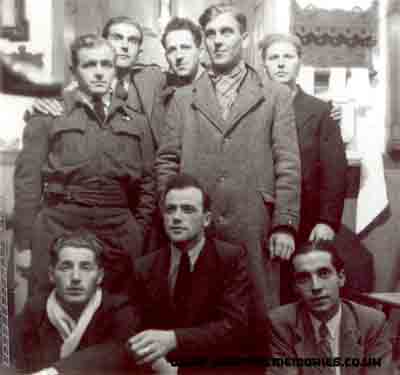 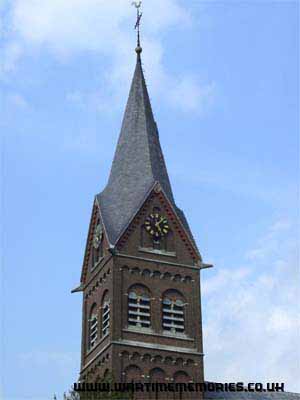 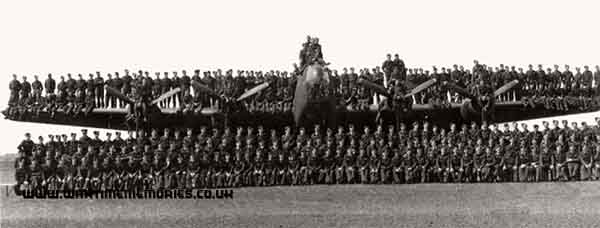 My Uncle, Flight Lt Johnstone, pilot, RCAF, wrote:
It would be the 8th trip on our second tour of bombing operations. Night of June 16/17-airborne at about 2200 hours, the target was a part of the munitions complex in the Rhur Valley. No big deal and no problems. On leaving the German border behind, we were in and out of the tops of cloud at around 16,000 feet and homeward bound over Holland. Time to break out some flight rations of orange juice and candy bar. Wham! A burst of cannon shell holes a few inches apart, traced a pattern from the bomb aimers position, through the navigator's table and angled through the left side of the instrument panel past the port inner engine which was set afire. Going into some fairly wild weaving with height change, we shut down the port inner, deployed the one shot fire extinguisher and took stock. The navigator, John Burns had just pulled his feet back to relax and was uninjured. "Dinger" Bell was still prone in his position and received some injury to his left ribs. The aircraft was flyable. Right away, another burst of swept the port wing root and reestablished fire in that engine. Worse still, the wing began to vibrate and a major aileron control problem was developing. Bail out! Proof the the Germans had developed some mighty sophisticated radar and guns in their aircraft was evident.
They were flying Halifax MZ-537 SE-L from Croft and crashed near Druemel in The Netherlands. Names of crew were Sgt JC Fereday, Flight Engineer RAF, F/Lt JC Burns, Navigator RCAF, F/O C Bell, Bombardier RCAF, F/O Lloyd Oliver Stanley, Telegrapher RCAF, F/O MB Steeves, gunner RCAF and F/O RJ Oates, gunner RCAF. Mervyn learned that Stanley, Fereday and Oates were uninjured but were captured by the Germans shortly after landing. Burns and Steeves were at farmhouses close by and Bell was tended by a doctor who had underground connections. Lifelong friendships were made especially with the van Gelder family in Alforst. They were hidden well by the wonderful Dutch folk! On July 16 they travelled in pairs on cycles to town of Hertogenbosch, then boarded a train for Eindhoven. They were then to cycle in pairs to Belgian border but 10 miles from the border the guide that was leading them disappeared and subsequently the four of them were rounded up. They ended up in Stalag Luft 1 Barth Vogelsang until the end of the war.
|
Victor Baker 434 Bluenose Squadron. (d.20th Jan 1944 ) Victor Baker served as a Flt Engineer with 434 Bluenose Squadron
|
F/O. Roy Carter 434 Squadron (d.9th Jul 1944) My brother, F/O Roy E. Carter, RCAF, was a navigator with the Blachford crew ( shot down on June 17, 1944 on the Sterkrade OP) He was an evader until executed by the Gestapo in Tilburg, Holland on July 9, 1944 with two others ( RAF and RAAF). See Todd`s `Pilgrimages of Grace` for details or see his story at www.bombercrew.com On this site you will also see the story of my cousin, F/O Joe R. Latremouille RCAF W/OP KIA March 11, 1944 ( Essen OP). He was with 434 and also flew from Croft. I have visited Croft (2003)and it was a thrilling time for me to see the site almost 60 years after two family members had flown from there.
|
Sgt P R A Dack 434 Bluenose Squadron. (d.20th Jan 1944 )
|
Sgt H B Hill 434 Bluenose Squadron. (d.20th Jan 1944 )
|
P/O W M Kipp 434 Bluenose Squadron. taken POW 20th Jan 1944
|
Angus McKay 78 conversion flight My father, Angus MacKay, served at Croft in 1942. He was a wireless operator air gunner u/t with 78 conversion flight. He flew in a whitley that crashed at Croft and to the day he died he had a burned wrist due to the crash. He flew on the 1000 bomber raid. 78 was notorious as the biggest squadron of Halifaxes and NCO aircrew who should have been officers. The crews were allowed to live out. My mum rembered my father coming home in the mornings with his uniform smelling of woodsmoke. A senior officer swore at my father and his Highland roots, that night my father broke into the officers mess and cut off half of his handlebar moustache as he slept. My father never spoke of his war but he only said a Halifax was known as The Queen of the skies because it could be landed with ease, it was also very easy to get out. He went to the HCU and was grounded with an abscess in the ear, he was at the big hospital in Blackpool and there saw Ken Dodd s first performance. I researched my fathers war - it was not good.
|
F/Sgt A M Wilson 434 Bluenose Squadron. taken POW 20th Jan 1944
|
Ron "Dutch" Holland 434 Squadron I crewed up at 1659 HCU Topcliffe as a RAF flight engineer of an all-Canadian crew. I then went on to do a tour with 434 Sqdn RCAF at Croft with 6 Group.
|
Sqdn.Ldr. Geoffrey Frank Keen CGM, DFM. 51 Sqdn. and 427 Sqdn Geoffrey Keen served with 51 Squadron and 427 Squadron.
|
P/O. Stewart W. Murphy 431 Squadron 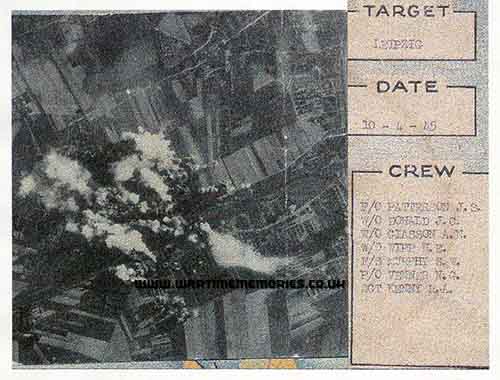 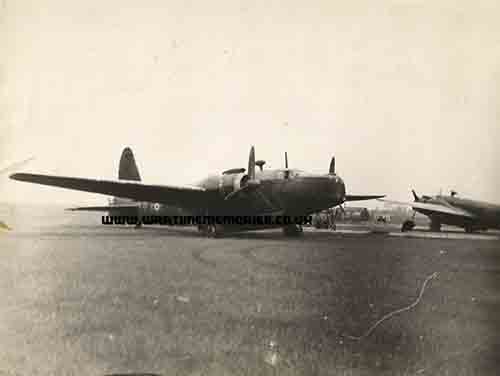 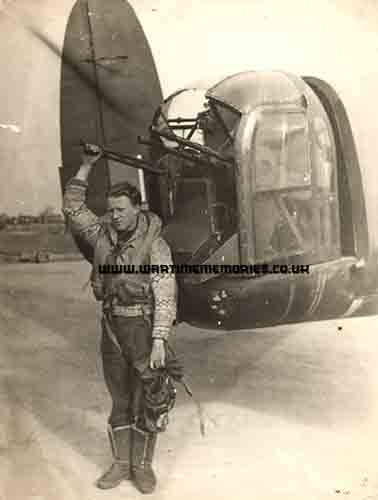 Target Hamburg by Stewart W. Murphy, Former Pilot Officer, Rear Gunner 431 (Iroquois) Squadron R.C.A.F. Stationed at Croft, Yorkshire, England.
One of my most memorable operations was a so called routine raid on the Hamburg submarine pens, 31st of March 1945. Although, it started out as a routine day, it would grow progressively worse. The weather was deteriorating fast. We would have to bomb on H2S radar through heavy clouds. To further complicate things, our fighter escort was late and would not get there in time of the bombing run, our most vulnerable time.
As was usual on all of our trips, the crew would report to the Navigator anything that appeared unusual, just to pass the time. An unusual situation was developing far to our rear. I could just make out what looked like a bomber blowing up.
It seemed like several minutes, but it was really only seconds before I could make out what looked like a twin engine fighter off our starboard rear quarter. It appeared several hundred yards off, streaming past the bombers to our rear. It was not one of our escorts. In the last few minutes I recognized it was a ME262 jet. It was a real surprise, we had never seen on before! I calmly raised my voice and asked the Pilot to corkscrew to starboard. I let off a short burst with my four Browning 303's which caught the jet full on to its port engine. The jet just blew up as it peeled over into the clouds. I reported what happened and we resumed our normal course. A few seconds later my racing thoughts were interrupted by the mid-upper gunner. He cried, "There's another one coming in higher from the rear." We dived again to the starboard and we let loose with all of our guns. The fighter seemed to just hang there for a second before the cockpit and port engine exploded.
Blowing "something" out of the sky can be described as a strange marriage of excitement, fear and disgust. That "something" had once threatened our aircraft. It could have very easily been our aircraft going down in flames. I continued to count the bombers blowing up as we left the target area. It was later confirmed that we lost 21 Lancaster and the Germans lost 26 fighters. It was a staggering loss on both sides. Most of the German fighters were shot down by our tardy fighter escort. They used their favorite method of following the much faster jets back to their base and would then catch them with their wheels down when they came in to land. The German fighters were DEAD DUCKS before they knew it! We claimed two fighters that day. They gave us one and one-half (we had to share the second one with another Lancaster crew).
Authors note:
The R.C.A.F. flew Lanks, Hallys, & Wimpys out of #6 Canadian Bomber Group in Yorkshire, England. We flew mostly night raids, so our formations (or lack of one) was totally different than the boys in the Libs and Forts. We flew in what was known as a gaggle (as in gaggle of geese). Each aircraft was on his own, flying at predetermined heights, usually spread between 17 and 20 thousand feet; arriving over the target rather strung out. At night we were one of many hundred aircraft sharing the sky. Often the only aircraft you would see was one of ours going down. It would light the sky for a minute, then we were back to that black anonymity of being alone again... or so you hoped.
About the photographs.
I did 32 operations in this Lanc as Tail Gunner. She flew 61 missions before she was flown home to be part of the Tiger Force, which was being formed to take part in the Pacific war. I flew 18 missions on her and 13 on Halifax Bombers as Tail Gunner. I had several "interesting" trips in both types. One of the most "interesting" raids was on Hamburg where we were attacked by 90 JU88s and the, then new, ME262s. My mid-upper gunner and myself shot down two ME262s, all told we lost 21 Lancasters they lost 26 fighters.
In the picture of the turret, you can see the front perspective plastic has been removed, leaving the tail gunner open to the elements. Although, this gave us much better visibility, it also made it very cold. When flying 18,000 to 20,000 feet, it was often 40 or 50 degrees below zero outside. We were bundled up in four layers of clothing, including an electric suit (that came with electric gloves and slippers). The main drawback to this was the fact you worked up a sweat before take off, so when you plugged in you usually got zapped with a shock. This made you put off plugging in until you were damn near frozen.
|
F/O. Donald Daubney Connor DFC. 431 Squadron (d.1st November 1944) Flying Officer (Pilot) Donald Connor was the son of Mr. and Mrs. W. M. Connor of Ottawa, Ontario, Canada.
|
P/O. Raymond Conserdine Joiner 431 Suadron (d.1st November 1944) Pilot Officer (Flight Engineer) Raymond Joiner served with 431 Squadron flying from RAF Croft.
|
F/O. James Joseph Mulvaney 433 (Porcupine) Squadron 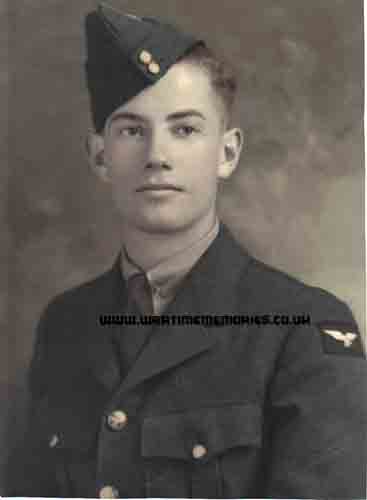 My Dad, James Mulvaney enlisted in March 1942 in Vancouver, British Colombia. He was posted to No.3 Manning Pool, Edmonton, Alberta for training, was then posted to Regina, Saskatchewan and upon graduation traveled across Canada to Halifax, Nova Scotia. He departed Halifax in January 1943 and arrived in Greenock, Scotland in early February. From there he went to Bournemouth, England and spent the next several months training in various locations in England, but always returning to Bournemouth to await further orders. He was in Bournemouth on Sunday May 23rd 1943 when the Germans attacked with 26 Focker Wolf 190's, killing over 130 and wounded hundreds. My Dad was across the street from Bobby's & Co. when it was shelled and severely damaged. Around midnight on Tuesday 21st of September 1943, while returning from a Bullseye training mission, his Whitley aircraft was hit by British anti-aircraft fire over London (London was under siege by German Luftwaffe planes), lost an engine and eventually crashed in Denham Golf Course, about 3 miles northwest of Uxbridge and about 18 miles west of London. All crew members survived. Following his Heavy Conversion Unit training with 1664 HCU at Croft Air Station in Croft, Yorkshire, Dad was assigned to 433 (Porcupine) Squadron of the Royal Canadian Air Force stationed at Skipton-on-Swale, Yorkshire, where his crew flew Handley Page Halifax Mk III heavy bombers. On the night of 24th/25th of February 1944, Dad's crew was on a bombing mission over Schweinfurt, Germany when their aircraft was shot down. All crew members parachuted to safety and were captured. Dad spent the remainder of the war as a Prisoner of War in several German camps such as Stalag Luft VI at Heydekrug in East Prussia, then, as the Russians pressed westward he was moved to Stalag 357 in Thorn, Poland, where he spent 4 weeks. In September 1944 Stalag 357 Thorn was closed due to advancing Russian troops and the prisoners were moved to Stalag 357 Fallingbostel, Oerbke, Germany (using the same Stalag number as Thorn). Food was in short supply and Red Cross packages rarely arrived, when they did, most of the contents had already been pilfered. On 7th of April 1945 Dad and his fellow Prisoners of War were forced to leave Stalag 357 at bayonet point. Hitler ordered all Prisoners of War to a redoubt area. This was the beginning of a 26 day forced march. Many prisoners died along the way from disease, starvation or friendly fire from RAF Hawker Typhoon's and other fighter/bombers. Dad was liberated in early May 1945, returned to England and eventually back to Vancouver. Following many weeks of hospital recovery, he married his high school sweetheart on 27th of August 1945, raised 4 children, and had a successful career with Finning Tractor. He survived my mother's passing in after 61 years of marriage and passed away in 2014.
|
Sgt William John Oram WOP/AG 427 Squadron (d.22nd January 1943) Billy Oram gave his date of birth as 1 year earlier than his real birth date in order to be accepted for service with the RAF. He served as a Wireless Operator 427 Squadron, Royal Canadian Air Force. He was a very keen southpaw boxer and he won several Inter Services Boxing Cups. He did at one time spar with Freddie Mills who later became a national Light Heavyweight Champion.
I was only 9 years old when he was killed in action so I am very unsure of my facts about Billy.
85 aircraft made a mine laying raid near the Frisian Islands but 6 aircraft including his, did not return and therefore there was no burial. He is commemorated on Panel 160 of the Air Forces Memorial at Runnymede.
He was in Wellington Bomber Mark lll serial number X3873 ZL-R and flew from RAF Croft and was one of the most northern airfields.
His crew mates were,
- Flight lieutenant DA Shead - Pilot
- Sgt. GR Hoyt - Observer
- Pilot Officer - M Patrick - Bomb Aimee
- Sgt. WJ Oram - Wireless Operator/Air Gunner
- Sgt. JL Sparling - Air Gunner
He was awarded three medals. The Aircrew Europe Star. The War Medal and The 1939-1945 Star.
|
Recomended Reading.Available at discounted prices.
|
Pilgrimages of GraceA A B Todd
|
|
|










